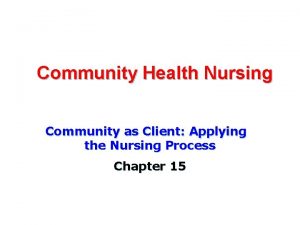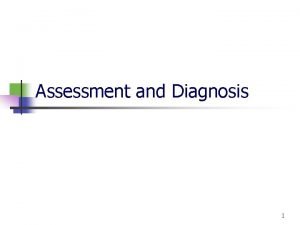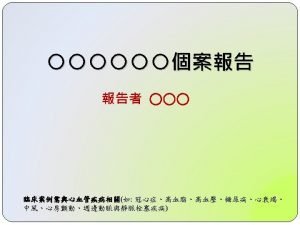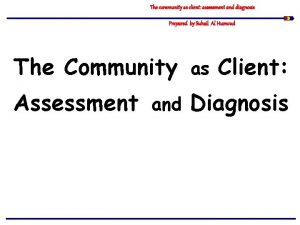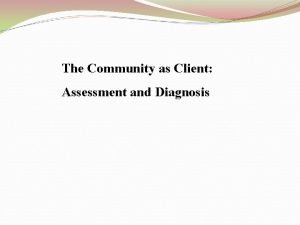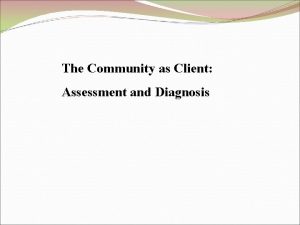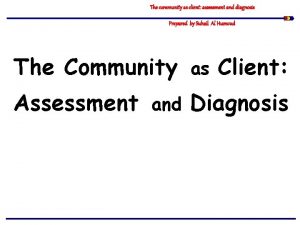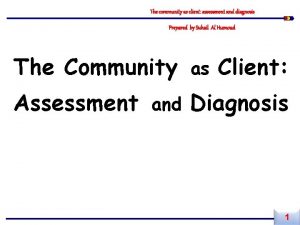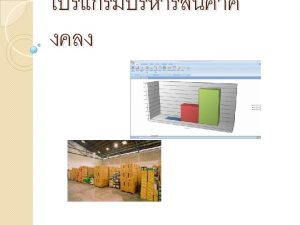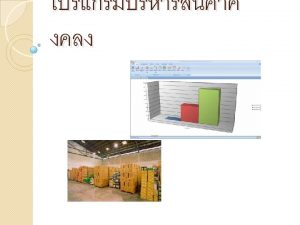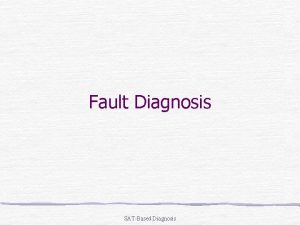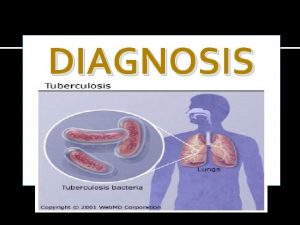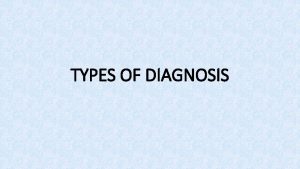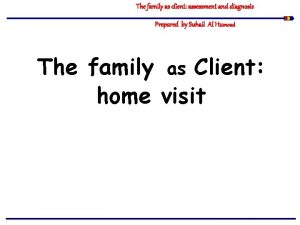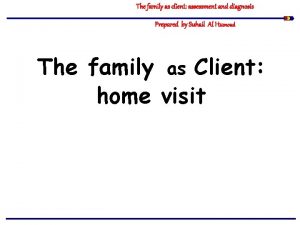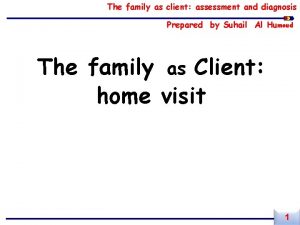The Community as Client Assessment and Diagnosis Community

























































- Slides: 57

The Community as Client: Assessment and Diagnosis

Community health nurses work with clients at several levels as: • Individuals • Families • Groups • Subpopulation • Populations • Communities

Although community health nurses work at all six levels of practice, working with communities is a primary mission for two important reasons: 1. Community directly influences the health of individuals, families, groups, subpopulation, and populations who are a part of it. • For example, if a city fails to take aggressive action to stop air pollution, the health of all its citizens will be adversely affected.

2. Provision of most health services occurs at the community level. • Community agencies help develop specific health programs and disseminate health information to many types of groups and populations.

v The community health nurse, then, must work with community as the client. The community as client refers to the concepts of a community- wide group of people as the focus of nursing service. § Understanding the concept of the community as client is a prerequisite of effective service at very level of community nursing practice.

Dimension of the community as client Chapter 1 defined a community as having three features: (1) Location, (2) Population (3) Social system. This three – dimensional view is especially appropriate for consideration of a local community, which can vary in location if the geographic boundaries are expanded or constricted ( Fig. 18 - 1)


It is useful to think of these three dimensions of every community as providing a rough map that one can follow in assessing needs or planning for services provision. Further guidance in assessing the health of a community is provided in the community Profile Inventory found Tables 18 -2, 18 -3, and 18 -4. In considering each dimension, one should pay particular attention to the questions that must be asked to assess the health of a community.

Location: Every physical community carries out its daily existence in a specific geographic location. The health of a community is affected by location, because placement of health services, geographic features, climate, plants, animals and the human made environment are intrinsic to geographic location. The location of a community places it in an environment that offers resources and also poses threats.

* The healthy community is one that makes wise use of its resources and is prepared to meet threats and dangers. In assessing the health of any community, it is necessary to collect information not only about variables specific to location but also about relationships between the community and its location. * Do groups cooperate to identify threats? Does the community make certain that its members are given available information about resources and dangers? * Table 18 -2 describes the location perspective of the community profile inventory, including the six location variables: community boundaries, location of health services, geographic features, climate, flora and fauna, and the humanmade environment


Population When one considers the community as the client, the second dimension to examine is the total population of the community. Population consists not of a specialized aggregate but of all the diverse people who live within the boundaries of the community.

The health of any community is greatly influenced by the attributes of its population. Various features of the population suggest health needs and provide a basis for health planning.

Community health nurses can better understand any community by knowing about its population variables: size, density, composition, rate of growth or decline, cultural characteristics, social class structure, and mobility. Table 18 -3 presents the population perspective section of the community profile inventory.


Social system In addition to location and population, every community has a third dimension- a social system. The various parts of a community's social system that interact and influence the system are called social system variables. These variables include the following systems: health, family, economic, educational, religious, welfare, political, recreational, legal and communication.

The community health nurse needs to understand the community as a social system. A community health nurse working in a tiny village in Alaska needs to grasp the social system of that village no less than a nurse working in New York City. Table 18 -4 guides the nurse in assessing a community's social system variables.


The concept of a social system A social system is an abstract concept and can be more readily understood by first considering the people who make up the community's population. Each person enacts multiple roles, such as parent, spouse, employee, citizen, and political volunteer. People in certain roles tend to interact more closely with others in related roles, such as a supervisor with a staff nurse. The patterns and interactions that emerge from these interactions among roles form the basis of organizations. Some organizations are informal (e. g. , an extended family group).


Other organizations, such as a city police department or a software business, are more formal. However, all organizations are constructed from roles that are enacted by individual citizens. Organizations, in turn, interact with one another, forming linkages. For example, a medical equipment company and a laboratory establish contracts (linkages) with a home care agency. When a group of organizations are linked and have similar functions, such as all those providing social services, they form a community system or subsystem (Fig. 18 -2). The various community systems have a profound influence on one another. Because this interaction among parts determines the health of the whole, it is the total social system that concerns community health nurses.

The health care delivery system as part of the social system Although community health nurse must examine all the systems in a community and must understand how they interact, the health system is of particular importance. Studying the health system in a community can be compared with assessing an individual client. The latter involves a head-to-toe examination looking for indications of wellness and illness in the respiratory, musculoskeletal, glandular, skin, and circulatory systems, among others, Initial assessment of a community also begins with a survey of its ten major social systems, before asking how well the specific parts are functioning.

The major function of the health system is to promote the health of the community. Community assessment asks not merely whether, but also how well, the system is functioning. What is the level of health promotion carried out by the health system of a community? To answer this question, one needs a clear notion about the subsystems, organizations, and roles that make up the system.

Community Dynamics: The discussion to this point may have suggested that the community is a rigid structure composed of a geographic location, a population, and a social system. Yet every community has a dynamic or changing quality.

Think of the diagram in Figure 18 -2 as a wheel that turns as the community changes. Three factors in particular affect community dynamics: 1. 2. 3. Citizen participation in community health programs. The power and decision-making structure. Collaborative efforts of the community (Lynd, 1939).

1. Citizen Participation: In some communities, citizens show little concern about public health issues and rely on health officials to take the entire responsibility. When such apathy abounds, community health nurses need to promote community education and awareness.

One goal of a community nurse when working with families or groups is to encourage people to participate and take responsibility for their own health care. Community self-care is community health nursing's goal.

2. Power and Decision-Making Structure: The second dynamic factors, the power and decisionmaking structure of a community, is a central concern to anyone who wishes to bring about change. The description of the community as a social system may suggest that power and decision-making reside primarily in the political system.

3. Community Collaboration Efforts: The third component of a functioning community social system is the degree to which the community collaborates. Community collaboration refers to the ability of the community to work together as a team of citizens professionals and lay people alike – to meet an identified need in the community.

There are several broad principles that underpin collaboration efforts. 1. Central to client and community well-being is a recognition that public policy issues are beyond the scope of any single person's or profession's responsibility. 2. The community needs results-based accountability that emphasized programs "or projects" effectiveness as the goal.

Ethical behavior is fundamental to collaborative relationships. People work in teams that cross traditional lines of programs, agencies, disciplines, and professions. Funding strategies need to be coordinated to give more flexibility at the community level, thereby providing a better way of allocating resources where they are needed.

Types of Community Needs Assessment: After considering the importance of community dynamics, the community health nurse is ready to determine the community's needs.

Assessment is the first step of the nursing process. Assessment for nurses means collecting and evaluating information about a community's health status to discover existing or potential needs as a basis for planning future action. Assessment involves two major activities. The first is collection of data and the second is analysis and interpretation of data.

Community needs assessment is the process of determining the real or perceived needs of a defined community. The type of assessment depends on variables such as the needs that exist, the goals to be achieved, and the resources available for carrying out the study.

Types of Community Assessment: Familiarization or "Windshield Survey": Familiarization assessment involves studying data already available on a community, and gathering a certain amount of firsthand data, to gain a working knowledge of the community. Such an approach, sometimes called “windshield survey” is used by new staff members in community health agencies.

Nurses drive (or walk) around the community; find health, social, and governmental services; obtain literature; introduce themselves and explain that they are working in the area; and generally become familiar with the community.

Problem-Oriented Assessment: A second type of community assessment, problemoriented assessment, begins with a single problem and assesses the community in terms of that problem.

The problem-oriented assessment is commonly used when familiarization is not sufficient and a comprehensive assessment is too expensive. This type of assessment is responsive to a particular need. The data collected will be useful in any kind of planning for a community response to the problem.

Community Subsystem Assessment: In Community subsystem assessment, the community health nurse focuses on a single dimension of community life. For example, the nurse might decide to survey youth organizations to discover their roles in the community. Or to assess PHC.

Community subsystem assessment can be a useful way for a team to conduct a more thorough community assessment. If five members of a nursing agency divide up the ten systems in the community and each person does an assessment of two systems, they could then share their findings to create a more comprehensive picture of the community and its needs.

Comprehensive Assessment: Comprehensive assessment is used to discover all relevant community health information. A survey compiles all the demographic information on the population, such as its size, density, and composition.

Key informants are interviewed in every major system education, health, religious, economic, and others. Then, more detailed surveys and intensive interviews are performed to yield information on organizations and the various roles in each organization. A comprehensive assessment describes not only the systems of a community but also how power is distributed throughout the system, how decisions are made, and how change occurs.

Because comprehensive assessment is an expensive, timeconsuming process, it is seldom performed. Indeed, in many cases, such a thorough research plan might be a waste of resources and might repeat, in part, other studies. Performing a more focused study based on prior knowledge of needs is often a better strategy.

Community Assets Assessment: The final form of assessment presented here is assets assessment, which focuses on the strengths and capacities of a community rather than its problems.

The previously mentioned methods are needs oriented and deficit based – in other words, they are "pathology" models, in which the assessment is performed in response to needs, barriers, weaknesses, problems, or scarcity in the community. This may result in a fragmented approach to solutions for the community's problems rather than an approach focused on the community's possibilities, strengths, and assets. This approach requires that the assessor look for the positive, or see the glass as "half full".

Community Assessment Methods: Community health needs may be assessed by a variety of methods. Four important methods are discussed here: 1. 2. 3. 4. Surveys Descriptive epidemiologic studies. Community forums or town meetings. Focus groups.

1. Survey: A survey is an assessment method in which a series of questions is used to collect data for analysis of a specific group or area.

1. Planning Phase: Select survey method or instrument to be used (eg, interviews, telephone calls, questionnaires). Determine sampling size (eg, a percentage of the total population in question).

2. Data Collection Phase. 3. Data Analysis and Presentation Phase Report results, including implications, recommendations.

2. Descriptive Epidemiologic Studies: A second assessment method is a descriptive epidemiologic study, which examines the amount and distribution of a disease or health condition in a population by person (who is affected? ), by place (Where does the condition occur? ), and by time (When do the cases occur? ).

3. Community Forums or Town Hall Meetings: The community or town hall meetings is a qualitative assessment methods designed to obtain community opinions. It takes place in the neighborhood of the people involved, perhaps in a school gymnasium or an auditorium. This method is used to elicit public opinion on a variety of issues, including health care concerns, political views, and feelings about issues in the public eye.

4. Focus Groups: This fourth assessment method, focus groups, is similar to the community forum or town hall meeting in that it is signed to obtain grassroots opinion. However, it has some differences. First, there is only a small groups of participants, usually 5 to 15 people.

The members chosen for the group are homogeneous with respect to specific demographic variables. For example, a focus group may consist of female community health nurses, young women in their first pregnancy, or retired businessmen. Usually the group meets for 1 to 3 hours, and there be a series of meetings.

Sources of Community Data There are many places the community health nurse can look for data to enhance and complete a community assessment. Data sources can be primary or secondary, and they can be from international, state, or local sources. Web sites for many primary and secondary data sources are included at the end of this chapter.

What is a Healthy Community? The following descriptors can serve as a guide for assessing a healthy community. The healthy community: 1. 2. Is one in which members have a high degree of awareness that "we are a community". Uses natural resources wisely while taking steps to conserve them for future generations.

3. Openly recognizes the existence of subgroups and welcomes their participation in community affairs. 4. Is prepared to meet crises. 5. Is a problem-solving community; it identifies, analyzes, and organizes to meet its own needs.

6. Has open channels of communication that allow information to flow among all subgroups of citizens in all directions. 7. Seeks to make each of its systems' resources available to all members of the community. 8. Has legitimate and effective ways to settle disputes that arise within the community. 9. Encourages maximum citizen participation in decision -making 10. Promotes a high level of wellness among all its members. Finish
 What is the nursing process steps
What is the nursing process steps Medical diagnosis and nursing diagnosis difference
Medical diagnosis and nursing diagnosis difference Second phase of nursing process
Second phase of nursing process Nursing process and critical thinking
Nursing process and critical thinking Perbedaan diagnosis gizi dan diagnosis medis
Perbedaan diagnosis gizi dan diagnosis medis Zero client vs thin client
Zero client vs thin client Client léger client lourd
Client léger client lourd Example of two tier architecture
Example of two tier architecture Community as client
Community as client Assessment for diagnosis
Assessment for diagnosis Social work assessment questions example
Social work assessment questions example Clients needs assessment
Clients needs assessment Biochemical data, medical tests, and procedures (bd)
Biochemical data, medical tests, and procedures (bd) It is the blueprint of nursing process
It is the blueprint of nursing process 3 part nursing diagnosis examples
3 part nursing diagnosis examples Mental health nursing process
Mental health nursing process Purpose of community diagnosis
Purpose of community diagnosis Community diagnosis
Community diagnosis Community as a client
Community as a client Familiarization assessment
Familiarization assessment Hát kết hợp bộ gõ cơ thể
Hát kết hợp bộ gõ cơ thể Bổ thể
Bổ thể Tỉ lệ cơ thể trẻ em
Tỉ lệ cơ thể trẻ em Gấu đi như thế nào
Gấu đi như thế nào Glasgow thang điểm
Glasgow thang điểm Bài hát chúa yêu trần thế alleluia
Bài hát chúa yêu trần thế alleluia Môn thể thao bắt đầu bằng từ chạy
Môn thể thao bắt đầu bằng từ chạy Thế nào là hệ số cao nhất
Thế nào là hệ số cao nhất Các châu lục và đại dương trên thế giới
Các châu lục và đại dương trên thế giới Công thức tiính động năng
Công thức tiính động năng Trời xanh đây là của chúng ta thể thơ
Trời xanh đây là của chúng ta thể thơ Cách giải mật thư tọa độ
Cách giải mật thư tọa độ 101012 bằng
101012 bằng Phản ứng thế ankan
Phản ứng thế ankan Các châu lục và đại dương trên thế giới
Các châu lục và đại dương trên thế giới Thơ thất ngôn tứ tuyệt đường luật
Thơ thất ngôn tứ tuyệt đường luật Quá trình desamine hóa có thể tạo ra
Quá trình desamine hóa có thể tạo ra Một số thể thơ truyền thống
Một số thể thơ truyền thống Cái miệng nó xinh thế
Cái miệng nó xinh thế Vẽ hình chiếu vuông góc của vật thể sau
Vẽ hình chiếu vuông góc của vật thể sau Thế nào là sự mỏi cơ
Thế nào là sự mỏi cơ đặc điểm cơ thể của người tối cổ
đặc điểm cơ thể của người tối cổ Thứ tự các dấu thăng giáng ở hóa biểu
Thứ tự các dấu thăng giáng ở hóa biểu Vẽ hình chiếu đứng bằng cạnh của vật thể
Vẽ hình chiếu đứng bằng cạnh của vật thể Phối cảnh
Phối cảnh Thẻ vin
Thẻ vin đại từ thay thế
đại từ thay thế điện thế nghỉ
điện thế nghỉ Tư thế ngồi viết
Tư thế ngồi viết Diễn thế sinh thái là
Diễn thế sinh thái là Các loại đột biến cấu trúc nhiễm sắc thể
Các loại đột biến cấu trúc nhiễm sắc thể Bảng số nguyên tố lớn hơn 1000
Bảng số nguyên tố lớn hơn 1000 Tư thế ngồi viết
Tư thế ngồi viết Lời thề hippocrates
Lời thề hippocrates Thiếu nhi thế giới liên hoan
Thiếu nhi thế giới liên hoan ưu thế lai là gì
ưu thế lai là gì Hươu thường đẻ mỗi lứa mấy con
Hươu thường đẻ mỗi lứa mấy con








